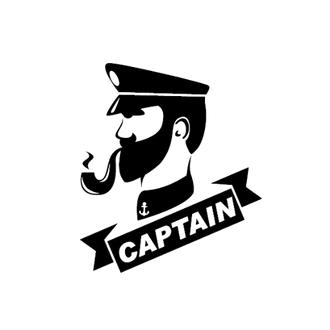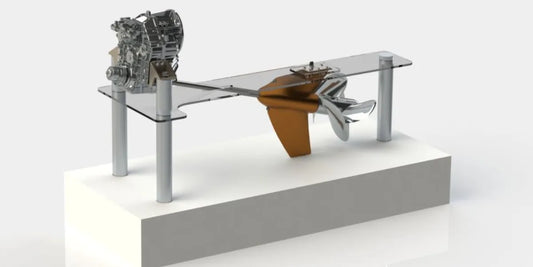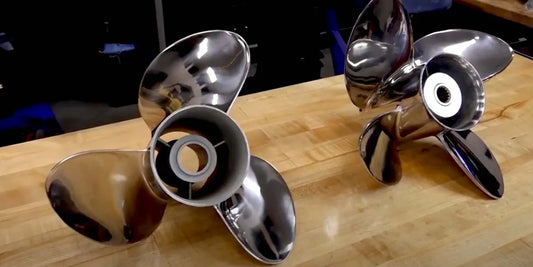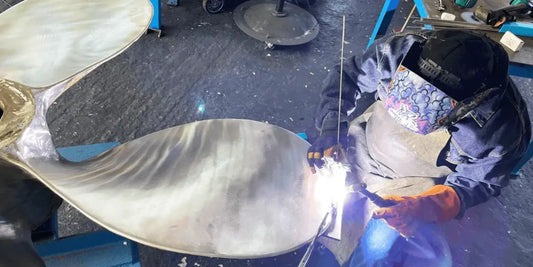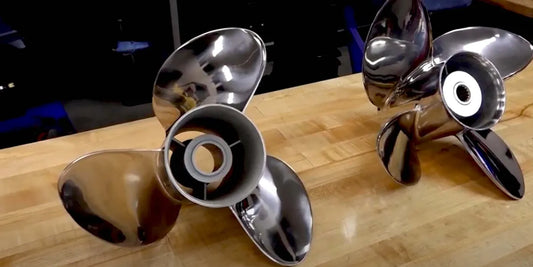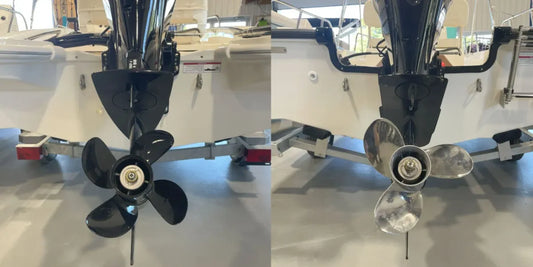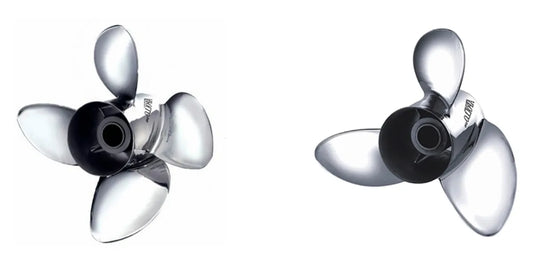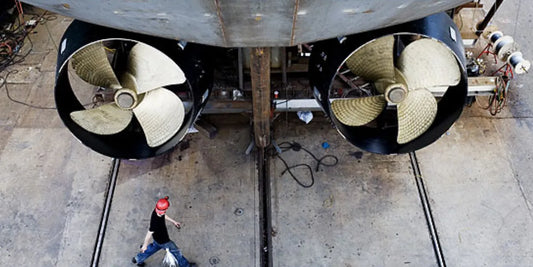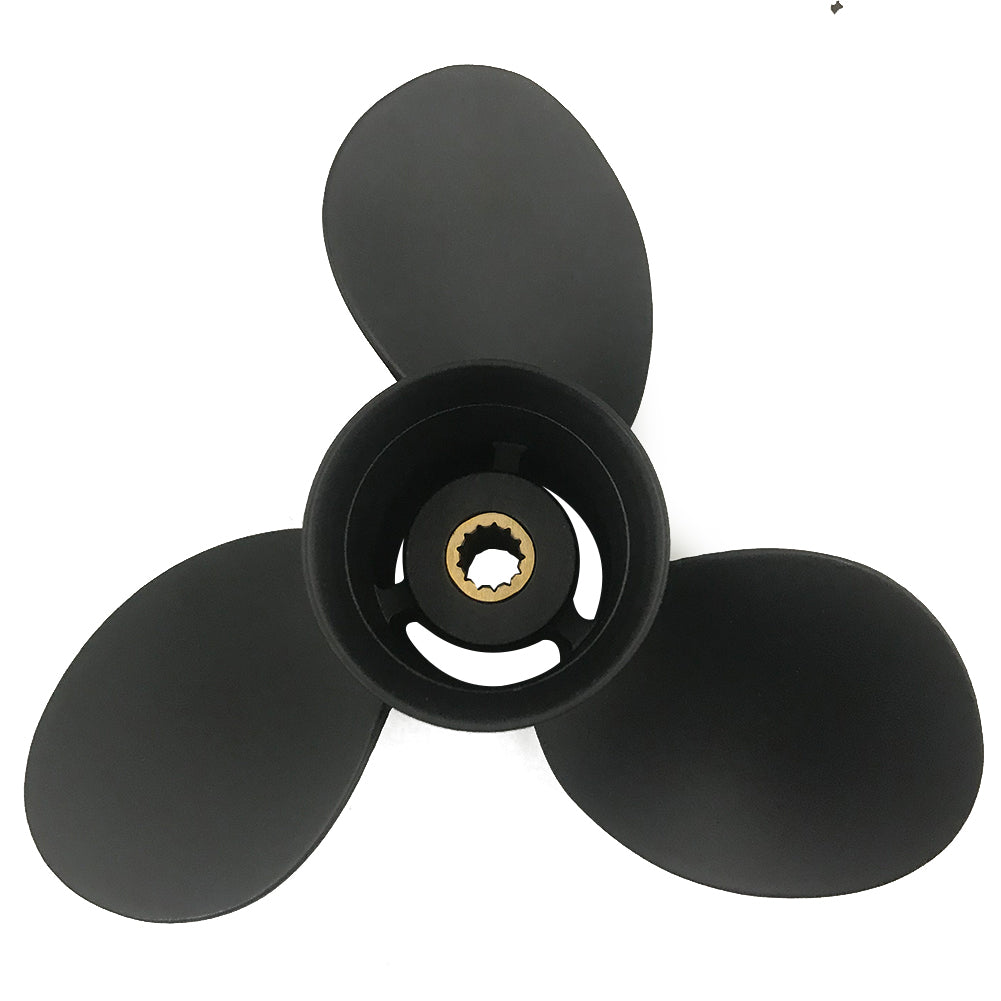A boating enthusiast will know how the choice of propeller pitch can affect vessel performance, fuel consumption, and handling characteristics. But when it comes to choosing between a 4-blade and 3-blade prop, the waters can get murky. Is one better than the other? Or does the better option depend on factors such as speed, load, or boating conditions? Our article then explores the fundamental differences between 4- and 3-blade propellers, examining how each type affects efficiency, maneuverability, and performance. Whether smooth rides, improved fuel economy, or enhanced speed are desired, this comprehensive guide will help you make the best possible choice for maximizing the boat's capabilities.
Understanding Propeller Design

What Is A Blade Propeller?
The blade propeller is a mechanical device that converts rotational power into thrust, enabling it to move forward through the water. Simply put, it consists of blades arrayed along the central hub, with the curvature and angle of each blade determined to achieve optimal propulsion, i.e., moving against water. The number of blades, shape, pitch, and diameter are all variables that determine propeller performance.
This would be similar to a 3-bladed propeller, considered efficient at high speeds because it offers less drag. It performs well as a top-end propeller and is light, which is why it is the preferred prop for speed-oriented applications. A 4-blade propeller however offers better surface area to grip the water under fair conditions, thus with improved stability and acceleration, and smoother operation under varying circumstances. This makes it suitable for rough water or where flat-water maneuverability is required.
The design decision is determined by factors such as the engine of your boat and the intended use or operating conditions. By making an informed choice, you can choose the perfect balance of speed, efficiency, and control. An understanding of blade propeller intricacies helps determine what is best for your needs while operating a boat.
Quick Overview Of 3-Blade And 4-Blade Props
3-blade and 4-blade propellers offer varying advantages that cater to different boat needs. A 3-blade propeller assumes a higher priority for top-end speed due to its lower drag and is more efficient under less demanding conditions. Fewer blades make 3-blade propellers the option best suited for faster acceleration and cruising speed.
4-blade propellers, on the other hand, assert themselves most forcefully in matters concerning stability and versatility in a variety of different conditions. They tend to be smoother to handle, with extra thrust from the additional blade, but often contribute to increased control in rough or choppy waters. Therefore, they are the propellers to choose when engaging in activities that demand precise handling, such as wakeboarding, towing, or navigating strong currents.
In recent years, 3-blade props have been noted to most often yield maximum velocity but feel more vibration than 4-blade props. Conversely, the 4-blade designs sacrifice very little in maximum speed for improved fuel economy, a better hole shot, and a more consistent feel at all speeds. It has also been proven that while the 4-Blade reduces ventilation and cavitation better than the 3-Blade, this advantage is much more noticeable on heavier boats or at lower RPMs.
Choosing between 3-blade and 4-blade propellers should best depict the special needs of your boat, its use, and environmental factors. Keeping these dynamics in mind will allow boaters to find a design that best suits their performance goals, whether they mean to optimize speed or achieve enhanced stability and control.
Basic Characteristics Of 3 And 4-Blade Propellers
See here some of the fundamental features that distinguish a 3-blade from a 4-blade. Performance characteristics that suit different kinds of boating needs: The 3-blade propeller is known for its speed, which enables high top speeds due to low drag. For a lighter boat or a situation that requires quick acceleration and the highest fuel efficiency, it would usually be the choice. Fewer blades equate to less friction of water, thus granting enhanced aerodynamic ability at higher speeds.
A 4-blade propeller is more suitable for applications that require better handling, stability, and thrust in rough conditions. It provides smoother operation at low RPMs, thus placing it in an excellent position for towing and handling heavy boats. A more substantial surface yields a more significant grip in water, as steerage in rough conditions can be frustrating and is equally problematic when a boat is heavier. A 4-blade propeller will provide proper low-speed maneuverability in certain situations and would be ideal for boats where handling is prioritized over outright speed.
While the 3-blade propellers offer the best chance for maximum speeds, the 4-blade models aim at steady control. With this background knowledge, boat owners will be able to identify the best propeller resources for achieving the optimal balance of performance, stability, and efficiency according to their specific working needs.
Performance Comparison: 3-Blade vs 4-Blade Prop

Efficiency and Speed: A More Thorough Look
When comparing 3-blade and 4-blade propellers, efficiency and speed become primary criteria for selecting the optimal propeller for varying boating conditions. A 3-blade propeller is designed primarily to maintain very high levels of speed by creating minimum drag and being the lightest configuration. Hence, with this setup, boats achieve higher top-end speeds, making it preferable in situations where speed must be maximized, such as in racing or water sports.
On the contrary, 4-blade propellers tend to focus more on efficiency at mid-range speeds. Due to the improved grip and larger blade surface area, they can exert a greater thrust force while experiencing less slippage under adverse conditions, such as rough waters or heavy loading. Therefore, they can be immensely helpful in fishing, cruising, or towing, where constant performance and fuel economy are all-important. The 4-blade propellers, on the other hand, are almost impervious to cavitation and offer super-smooth acceleration, guaranteeing that their services will be relied upon at varying levels of operations.
These details will help boaters align their propellers with their desired boat performance, whether it's maximum speed or a blend of power and stability. Working through those performances, they are then able to create an avenue for increased serviceability alongside pure enjoyment of the entire vessel.
Divergences in Handling and Maneuverability
As far as handling and maneuverability are concerned, a particular propeller impacts the overall behavior and responsiveness of the boat on the water. Generally speaking, a propeller with more blades tends to have smoother handling. Therefore, it would be suitable for activities requiring precise control, such as water sports or navigating tight spaces like marinas. With fewer blades, they generally maintain better speed and efficiency but compromise on stability during hard turns and sometimes on harsher weather or water conditions.
Pitch, on the other hand, plays a vital role in maneuverability. The primary advantage of using small-pitch propellers is to provide better acceleration and responsiveness in situations that require immediate short bursts of speed, such as towing or casual applications. Large-pitch props would maintain a high speed over longer distances but may reduce some finely tuned maneuvering capabilities under certain circumstances.
The diversity in the material of a propeller also affects maneuverability. Aluminum props are relatively lightweight and inexpensive, providing adequate handling in casual boating situations; however, stainless steel props are more durable and offer sharper performance. With these considerations in mind, serious boaters pursuing performance usually favor stainless steel for its longevity and consistent handling features.
By considering blade count, pitch, and material alongside intended boat usage, boaters can select a propeller that matches their unique requirements, ensuring premium handling and precise maneuverability for all types of water adventures.
Fuel Economy: Which One Saves More Fuel?
Fuel economy is considered one of the topmost factors when selecting the right propeller, as it has direct implications for operational costs and environmental consequences. Aluminum propellers, being lightweight, generally provide the best fuel efficiency for small boats and engines running at cruising speed. Less weight corresponds to less stress on an engine, meaning every inch of fuel mileage is achieved.
Heavyweight stainless steel propellers show maximum efficient performance at greater speeds, especially under harsh load conditions. The intrinsic stiffness of these propellers prevents blade flex and conserves energy, generating higher propulsion efficiency. Such fuel efficiency, while operating high-output engines on large boats, will pay back over time during long-haul trips.
Pitch and diameter also contribute to fuel economy. A propeller with a low pitch can increase the RPM of an engine, thereby enhancing acceleration, but this may result in increased fuel consumption. Conversely, a higher-pitch propeller would offer a balanced combination of speed and fuel-efficient cruising. Ideally, the choice of propeller material and specifications should be considered concerning the size of the boat, the type of engine it is equipped with, and its intended use. That will enable boaters to optimize fuel consumption while achieving other expected results satisfactorily.
Application and Usage Scenarios

Best Uses for 3-Blade Propellers
3-blade propellers are excellent for boats that demand a balance between speed, efficiency, and maneuverability. These propellers are commonly seen on motorboats, speedboats, and some utility crafts due to their superior performance criteria. For instance, 3-blade propellers offer a higher top-end speed than 4-blade ones and thus work beautifully when you're out on recreational water skiing or wakeboarding. At the same time, they offer very little resistance or drag at mid-range speeds, which is excellent for extended periods off the coast.
Best for quickly reaching high speeds, such as when coming on-plane or going through choppy waters, acceleration is critical with these propellers. They don't grip as well or provide as much stability compared to a 4-blade propeller. However, being lighter, they still ensure the engine's RPMs are at the highest possible level, set to provide an exhilarating and responsive boating experience. When the right prop pitch and diameter are combined with a 3-blade design, boaters can achieve a practical compromise in getting their engine to output power per their performance requirements while also considering fuel consumption.
When to Go For a 4-Blade Propeller
A 4-blade propeller can be selected when the user seeks better control, smoother handling, and excellent performance in less-than-ideal conditions. In comparison to the 3-blade propeller, the 4-blade design offers a greater surface area, resulting in increased thrust and reduced slippage in choppy waters or when towing heavy loads. These are somewhat ideal for large boats and vessels that demand steady speeds and precision, such as fishing boats or pontoons.
From the data, we see that 4-blade propellers tend to improve low-speed maneuvering, thereby making docking and navigating tight spaces significantly easier. Additionally, they reduce vibration and noise, providing recreational users with a comfortable boating experience. Although 4-blade propellers can marginally reduce top-end speeds, they offer a fair trade-off in terms of consistency in power and fuel economy, making them well-suited for cruising, water sports, and any activity that requires stable operation under varying conditions.
Factors Influencing Prop Selection for Your Boat
Choosing the right propeller for your boat is a decision influenced by several factors, each of which affects your vessel's performance, efficiency, and operation. Let us walk through some of the factors that should influence your choice:
Boat Usage and Activities: The type of activities you do with your boat largely influences the propeller choice. For example, if you are into skiing or wakeboarding, you would want a propeller locked for good acceleration and pulling power. Conversely, if you cruise for long distances, you want a propeller for fuel efficiency.
Engine RPM and Performance: Always consider the engine's recommended RPM range for your boat. With the propeller, the engine runs at its recommended RPM for optimal performance and efficiency. If the propeller is too large or too small, it strains the engine, decreases efficiency, and may cause damage.
Material and Construction: Propellers are made of aluminum and stainless steel. An aluminum prop is more cost-effective and suitable for casual boating; however, stainless steel props perform better and wear more evenly, making them ideal for harsh conditions or frequent use.
Pitch and Diameter: The larger the pitch or diameter, the greater the motor's speed and thrust. A larger-pitch propeller tends to impart a higher top speed but reduces acceleration, while a smaller-pitch propeller gives greater power and responsiveness. Balancing is crucial when matching the specific needs of the boat.
Boat Weight and Load: Heavier loading of the boat and additional passengers would require a propeller to generate more thrust. This consideration should also take into account the average weight distribution, allowing for smooth handling and overcoming the strain felt by the performance when navigating different conditions.
Water Conditions: Where you run it dictates whether it's calm lakes, coastal waters, or high-current rivers. A powerful one with a superior grip might be required in rough waters, while the lightweight options excel in calm, stable conditions.
Fuel Efficiency: Countless boaters strive to save fuel, and the right props can be a great help. Consider a propeller of good design, complementing the engine's power output while reducing fuel costs without compromising on quality or performance.
All factors must be equally weighed in line with the desired speed, handling, and efficiency. Through the adaptation of your prop selection to these factors, you will be able to enrich your overall performance with an outright satisfied boating experience.
Maintenance and Durability Considerations

Longevity: A Comparison between 3-Blade and 4-Blade Propellers
Longevity-wise, propellers with 3 and 4 blades are influenced by several factors, including the material they are made from, their operating conditions, and maintenance protocols. In general, the durability of propellers is less a function of the number of blades and more a function of the quality of the materials used in their manufacture, whether aluminum, stainless steel, or composite. Stainless steel propellers have the advantage of lasting much longer, as they offer corrosion resistance and resist dents and deformation on impact far better than aluminum propellers.
Blade numbers may affect wear patterns. A 4-blade propeller tends to share the load more or less equally among its blades, reducing the overall stress on any one blade more than does a 3-blade propeller. Such equal load distribution may indeed result in longer performance life, especially in conditions where heavy-duty or rough waters are common. However, 3-blade props, which are somewhat more prone to wear with rough usage, can be made comparably long-lasting when well maintained.
Hence, maintenance is a strong factor affecting the lifespan. Equally crucial for both 3- and 4-blade props are periodic inspections for damage, cleaning to prevent corrosive effects, and timely repair. Whatever you choose, a good-quality material, adherence to best practices in maintenance, and consideration of your boating usage will increase the life of either arrangement and optimize performance.
Maintenance for Different Blade Configurations
Maintenance is required for any propeller setup, be it a 3- or 4-blade one. With 3-blade props, maintenance inspections focus on ensuring the blades maintain their original profile and are free from chipping, bending, or deformation that could impact blade performance. These 3-blade configurations are a bit more forgiving in terms of wear and tear. Still, they should never be forgone when it comes to cleaning, especially after the propeller has been in saltwater or come into contact with debris.
Conversely, 4-blade propellers, owing to their complexity and given specific stresses induced by water, may demand more attention. Removal of buildup that compromises the full balance among all blades is essential, as any imbalance spells disaster for fuel efficiency and speed. Equally important is corrosion resistance, which means that the coatings or materials used must be of the utmost quality.
Studies show that maintaining propellers regularly, which includes blade alignment and fixing minor damages immediately, can enhance efficiency and lifespan by up to 20%. Through a maintenance regime tailored to the specific requirements of your propeller, you ensure optimal performance, minimize costs, and protect the longevity of your vessel's propulsion system.
Impact of Material Choices on Propeller Performance
The material composition significantly influences a propeller's performance, including its overall durability and efficiency. Generally, they have traditionally been manufactured from bronze, stainless steel, and aluminum, each exhibiting various advantages depending on the operational requirements. For instance, bronze is an excellent choice for resisting corrosion and cavitation, making it more suitable for marine environments. At the same time, stainless steel possesses good strength and disperses higher stresses among the blades in high-speed applications.
More recent trends are to use exotic materials such as titanium alloys, which are lightweight and capable of standing harsh conditions. Titanium, although more expensive, has paid for itself in the long term by improving fuel efficiency and reducing wear. Composite materials are becoming increasingly attractive for specialized vessels, as they offer lighter materials that resist fouling, thereby reducing maintenance.
According to data culled from various case studies, energy loss in the propellers attributed to the wrong choice of material can be reduced by as much as 15%, thereby increasing overall vessel efficiency. However, this choice would have to take into consideration operational conditions, such as water salinity, temperature variations, and thrust levels, which would undercut either of the two chosen materials and hence reduce premature wear to ensure maximum performance. By aligning material technology with vessel-specific applications, operators increase operational resilience, reduce downtime, and achieve cost-effective operations.
Conclusion: Making the Right Choice for Your Boat

Summarizing the Key Differences
When selecting suitable materials for a boat's components, it ultimately comes down to understanding the vessel's specific characteristics and its operational environment. I always consider material properties for particular needs, focusing on factors such as durability, corrosion resistance, and performance under various operating conditions. For example, stainless steel is the best choice because it offers the highest strength and corrosion resistance in high-salinity environments. In contrast, bronze is better suited for high durability and low wear in corrosive operational settings. Each material possesses different advantageous properties, which I use to direct my choices.
Other factors that I've found to play an essential role in terms of operational characteristics include water salinity, temperature variations, thrust requirements, and the ease of access for maintenance. All these factors help me make better decisions for a material that not only performs and operates well but also rejuvenates the service life of components while lowering cost in the long run. For me, the key is striking the right balance; ensuring that materials are tailored to the particular applications of my boat, while maintaining cost-effectiveness and dependability. This targeted choice will minimize premature wear, yield the best results, and provide genuine peace of mind during operation.
Summary Recommendations for Selecting a Prop
The most important consideration when selecting a propeller is to ensure that it fits the particular requirements of my boat and how it is intended to be used. This basic step involves having a thorough understanding of parameters such as engine power, hull type, and the expected load. Selecting the correct propeller means the vessel can perform at its utmost capacity and do so while using as little fuel as possible. Proper selection of pitch and diameter relative to the engine's RPM range is arguably one of the most influential factors in achieving maximum thrust, along with all other factors affecting operating efficiency.
The next important consideration I examine is the material, specifically the balance between good durability and cost. I look into stainless steel as it will cost more initially. Still, it will ensure the highest strength and corrosion resistance in environments where saltwater or high-performance applications are concerned. Aluminum hardware is well-suited for less demanding applications, offering an economical and lightweight solution. I then consider other factors, like the number of blades, which will all have an effect on acceleration, speed, and stability, depending on the water environment and activity, for example, cruising or water sports.
Selection and adjustment are the keys in my approach. It is valuable for me to observe the real-world performance after installation and make any necessary adjustments. The prop not only delivers better performance but is also less straining on the mechanical components, thereby extending the engine's life. A well-chosen prop can ensure that we get the best out of the entire boating experience, with reliability and reduced downtime.
Future Trends in Propeller Design
A growing trend in propeller design is the use of 3D printing for rapid prototyping and testing of new designs. This affords the ability to customize propeller designs to a greater extent than has ever been done before for specific vessel types or performance purposes, and thus helps reduce both production costs and material wastage. The freedom that 3D printers offer is beginning to address geometries that were previously impossible to achieve via more traditional means, accentuating the path of efficiencies.
The next interesting trend is the use of advanced materials, such as carbon fiber composites and titanium alloys. These materials offer a near-ideal blend of strength, durability, and light weight, resulting in enhanced performance and improved fuel economy. I can foresee an increasing demand for environmentally friendly solutions, which is aligned with the rise of electric and hybrid means of propulsion. These propeller designs are being refined to complement the new technology and achieve a further reduction in environmental impact, promoting greener boating.
Finally, my interests lie in computational modeling and AI-aided design for manufacturers of future-generation propellers. This allows engineers to conduct a performance variable analysis, with the finest details going into a design that produces maximum thrust while minimizing cavitation and noise. Keeping abreast of all these developments and applying them to my outfit gives me the confidence that I will continuously respond to developments in the maritime sphere.
Reference Sources
-
3-Blade vs. 4-Blade Propeller - Michigan Wheel
Discusses the differences in pitch and performance between 3-blade and 4-blade propellers. -
Which Prop is Better For Your Boat: 4 Blades or 3 Blades? - BoatTest
Explores efficiency, performance, and scenarios where 4-blade props outperform 3-blade props. -
What's the Difference Between 2, 3, and 4-Bladed Propellers? - Airplane Academy
Provides insights into the advantages and trade-offs of different blade counts, including 3- and 4-blade options. -
Typical Advantages and Disadvantages of Switching from 3 to 4 Blade Prop - The Hull Truth
Highlights the benefits of 4-blade props, including quicker planing and improved performance in rough conditions.
Frequently Asked Questions (FAQs)
What is the most significant difference between a 4-blade prop and a 3-blade prop?
There is a big difference in the performance factors between the two. Generally speaking, a four-blade propeller offers better hole shots and acceleration at low speeds, making it an excellent candidate for a recreational boat that requires quick planing. Alternatively, a 3-blade propeller performs well at top speed, where drag is less and the maximum RPM is higher. You have to consider which side your hull design is working for, and where the usage will be.
How does the blade number affect a boat?
Quite an essential effect on the performance of any boat is the number of blades on a propeller. Typically, these provide better top speed and efficiency at higher RPMs, while four-blade designs provide better handling and stability at lower speeds. A 4-blade propeller offers better performance at low speeds, making it particularly useful for fast acceleration scenarios, such as pulling skis or wakeboards. If fuel economy and top speed are your primary goals, a 3-blade may be a better option.
Can 4-blade propellers be fitted to an outboard engine?
Yes, a 4-blade propeller can be fitted to your outboard, but it must be compatible with your specific model. Several outboard motors are designed for use with various types of props, including 3- or 4-blade prop options. Switching to a 4-blade prop would likely give you an additional performance boost with better acceleration and stability at lower rpm's. Ensure that the pitch and diameter of your new prop match the specifications for your engine, allowing you to optimize for optimal performance.
What are the benefits of choosing a 4-blade prop over a 3-blade?
Several benefits arise from the use of a 4-blade prop, particularly in terms of handling and acceleration. A 4-blade prop generally excels at hole shot and can pull the boat away quickly from a standstill, which is excellent for tow activities. Furthermore, a 4-blade can offer smoother operation and less slip, contributing to better fuel economy; however, it may be slightly inferior to a 3-blade in terms of fuel economy and speed at high speeds.
In what ways does the diameter affect propeller performance?
The diameter of a prop significantly affects propeller performance. A prop whose diameter is larger generates more thrust, resulting in better acceleration and the ability to pull heavier loads. However, the diameter also leads to more drag, which in turn undermines top speed and might even harm fuel economy. Getting the diameter right is crucial, as it significantly determines the hole shot, rpm, and overall performance of the boat. Consequently, adjusting the diameter along with the blade number will help figure out the best prop for your needs.
What are the things to consider when choosing between a 3-blade and a 4-blade prop?
Several things need to be kept in mind when choosing between 3 and 4-blade props. These include the activities that you undertake in your boating, your hull design, and the performance characteristics that you desire. If you are looking for maximum top speed and fuel efficiency at higher rpms, then in all likelihood, a 3-blade propeller would best suit your needs. However, if you find that most of your applications are in situations where quick acceleration and stability at low speeds are required, then in all likelihood, a 4-blade prop would better serve you. Furthermore, the horsepower behind your engine, as well as the kind of boat you have, will also impact how effective either configuration is going to be for you.
